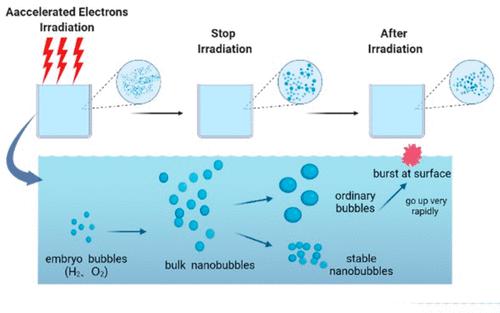Our official English website, www.x-mol.net, welcomes your
feedback! (Note: you will need to create a separate account there.)
Formation of Bulk Nanobubbles Induced by Accelerated Electrons Irradiation: Dependences on Dose Rates and Doses of Irradiation
Langmuir ( IF 3.7 ) Pub Date : 2022-06-21 , DOI: 10.1021/acs.langmuir.2c00515 Kaiwei Yuan 1, 2 , Limin Zhou 3 , Jing Wang 1, 2, 4 , Zhanli Geng 1, 2, 4 , Juncheng Qi 1, 2 , Xingya Wang 1, 3 , Lijuan Zhang 1, 2, 3 , Jun Hu 1, 2, 3, 4
Langmuir ( IF 3.7 ) Pub Date : 2022-06-21 , DOI: 10.1021/acs.langmuir.2c00515 Kaiwei Yuan 1, 2 , Limin Zhou 3 , Jing Wang 1, 2, 4 , Zhanli Geng 1, 2, 4 , Juncheng Qi 1, 2 , Xingya Wang 1, 3 , Lijuan Zhang 1, 2, 3 , Jun Hu 1, 2, 3, 4
Affiliation

|
Radiation on aqueous solutions can induce water radiolysis with products of radicals, H2, H2O2, and so on, and their consequent biological effects have long been interested in radiation chemistry. Unlike the decomposition of water by electric current that produces a significant number of bubbles, the gas products from the radiolysis of water are normally invisible by bare eyes, little is known on whether nanosized bubbles can be produced and what their dynamics are upon irradiation. Here, we first presented the formation of nanoscale bulk bubbles by irradiating pure water with accelerated electrons and their concentration and size distribution changes with the dose and rate of irradiation. The nanoparticle tracking analysis showed that irradiation can actually produce a certain amount of bulk nanobubbles in pure water. They exhibited a dependence on the irradiation dose rates and irradiation doses. The results indicated that the concentration of formed bulk nanobubbles increased as the irradiation dose rates increased, but it will increase and then decrease with the increased irradiation doses. The formed bulk nanobubbles could maintain stability for several hours. Our findings will provide a new angle of view for the radiation chemistry of water, and the formed nanobubbles may help elucidate the biological effects of irradiated solutions.
中文翻译:

加速电子辐照诱导的块状纳米气泡的形成:对剂量率和辐照剂量的依赖性
对水溶液的辐射可以用自由基 H 2、H 2 O 2的产物诱导水辐射分解, 等等, 以及它们随之而来的生物效应长期以来一直受到辐射化学的关注。与产生大量气泡的电流分解水不同,水的辐射分解产生的气体产物通常肉眼是看不见的,人们对是否可以产生纳米级气泡以及它们在辐照时的动力学特性知之甚少。在这里,我们首先展示了通过用加速电子照射纯水来形成纳米级大气泡,以及它们的浓度和尺寸分布随照射剂量和速率的变化。纳米粒子跟踪分析表明,辐照实际上可以在纯水中产生一定量的大块纳米气泡。它们表现出对辐照剂量率和辐照剂量的依赖性。结果表明,随着辐照剂量率的增加,形成的块状纳米气泡的浓度增加,但会随着辐照剂量的增加而先增加后减少。形成的块状纳米气泡可以保持数小时的稳定性。我们的研究结果将为水的辐射化学提供一个新的视角,形成的纳米气泡可能有助于阐明辐照溶液的生物学效应。
更新日期:2022-06-21
中文翻译:

加速电子辐照诱导的块状纳米气泡的形成:对剂量率和辐照剂量的依赖性
对水溶液的辐射可以用自由基 H 2、H 2 O 2的产物诱导水辐射分解, 等等, 以及它们随之而来的生物效应长期以来一直受到辐射化学的关注。与产生大量气泡的电流分解水不同,水的辐射分解产生的气体产物通常肉眼是看不见的,人们对是否可以产生纳米级气泡以及它们在辐照时的动力学特性知之甚少。在这里,我们首先展示了通过用加速电子照射纯水来形成纳米级大气泡,以及它们的浓度和尺寸分布随照射剂量和速率的变化。纳米粒子跟踪分析表明,辐照实际上可以在纯水中产生一定量的大块纳米气泡。它们表现出对辐照剂量率和辐照剂量的依赖性。结果表明,随着辐照剂量率的增加,形成的块状纳米气泡的浓度增加,但会随着辐照剂量的增加而先增加后减少。形成的块状纳米气泡可以保持数小时的稳定性。我们的研究结果将为水的辐射化学提供一个新的视角,形成的纳米气泡可能有助于阐明辐照溶液的生物学效应。











































 京公网安备 11010802027423号
京公网安备 11010802027423号